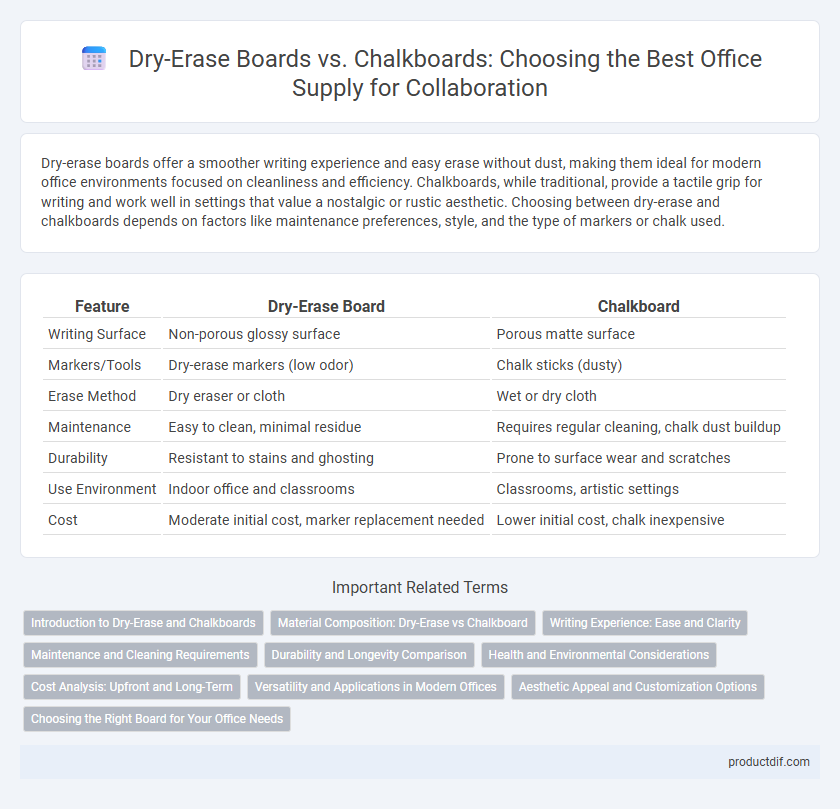Dry-erase boards offer a smoother writing experience and easy erase without dust, making them ideal for modern office environments focused on cleanliness and efficiency. Chalkboards, while traditional, provide a tactile grip for writing and work well in settings that value a nostalgic or rustic aesthetic. Choosing between dry-erase and chalkboards depends on factors like maintenance preferences, style, and the type of markers or chalk used.
Table of Comparison
| Feature | Dry-Erase Board | Chalkboard |
|---|---|---|
| Writing Surface | Non-porous glossy surface | Porous matte surface |
| Markers/Tools | Dry-erase markers (low odor) | Chalk sticks (dusty) |
| Erase Method | Dry eraser or cloth | Wet or dry cloth |
| Maintenance | Easy to clean, minimal residue | Requires regular cleaning, chalk dust buildup |
| Durability | Resistant to stains and ghosting | Prone to surface wear and scratches |
| Use Environment | Indoor office and classrooms | Classrooms, artistic settings |
| Cost | Moderate initial cost, marker replacement needed | Lower initial cost, chalk inexpensive |
Introduction to Dry-Erase and Chalkboards
Dry-erase boards use non-porous surfaces such as melamine, porcelain, or glass, allowing easy erasure with a dry cloth and reducing dust exposure compared to traditional chalkboards. Chalkboards feature a matte, porous surface typically made of slate or painted wood that requires chalk, producing dust that can irritate respiratory systems. Modern offices prefer dry-erase boards for their clean, low-maintenance use, while chalkboards offer a classic, tactile writing experience suitable for creative environments.
Material Composition: Dry-Erase vs Chalkboard
Dry-erase boards are typically composed of non-porous materials like melamine, painted steel, or glass, enabling easy and quick erasure without ghosting. Chalkboards are predominantly made of slate or painted wood surfaces that absorb chalk dust, making them less smooth and prone to residue buildup. The material composition directly impacts durability, cleaning ease, and writing clarity in office environments.
Writing Experience: Ease and Clarity
Dry-erase markers provide a smoother writing experience with consistent ink flow, ensuring clear, vibrant lines on glossy surfaces, while chalkboards offer a tactile, textured feel that some users find nostalgic but can produce dust and less precise strokes. The ease of erasing dry-erase markers from whiteboards results in cleaner, quicker corrections compared to chalk residue on boards. For environments prioritizing clarity and minimal maintenance, dry-erase surfaces enhance readability and writing efficiency over traditional chalkboards.
Maintenance and Cleaning Requirements
Dry-erase boards require regular cleaning with specialized erasers or alcohol-based cleaners to prevent ghosting and maintain a clear writing surface. Chalkboards demand frequent dusting and wiping with a damp cloth to remove chalk residue and avoid buildup that can dull the board. Both surfaces benefit from routine maintenance, but dry-erase boards typically offer easier and less messy cleaning compared to chalkboards.
Durability and Longevity Comparison
Dry-erase boards feature a non-porous surface that resists staining and ghosting, offering superior durability and longevity compared to traditional chalkboards, which can wear down and accumulate residual chalk dust over time. High-quality dry-erase boards maintain their clarity and erase cleanly for years with proper care, reducing maintenance costs and replacement frequency in office environments. Chalkboards, while cost-effective initially, often require resurfacing or replacement due to surface degradation and scratching from chalk use.
Health and Environmental Considerations
Dry-erase boards use non-toxic, low-odor markers that reduce respiratory irritation compared to chalkboards, which release chalk dust linked to asthma and allergies. Dry-erase markers often contain volatile organic compounds (VOCs) but many brands now offer eco-friendly, low-VOC options to minimize environmental impact. Chalkboards are generally more sustainable due to their long lifespan and the biodegradable nature of chalk, though dust production poses health concerns for sensitive individuals.
Cost Analysis: Upfront and Long-Term
Dry-erase boards usually have a higher upfront cost compared to chalkboards but offer lower long-term maintenance expenses, as markers are less dusty and easier to replace than chalk. Chalkboards are more affordable initially but require frequent chalk replenishment and more cleaning, potentially increasing ongoing costs. Evaluating total cost of ownership favors dry-erase boards in modern office environments due to durability and reduced maintenance needs.
Versatility and Applications in Modern Offices
Dry-erase boards offer superior versatility in modern offices due to their compatibility with color markers, easy wipe-off surface, and digital integration options for presentations and brainstorming sessions. Chalkboards, while providing a classic aesthetic, are less adaptable for frequent updates and often require more maintenance, limiting their use in fast-paced office environments. Dry-erase surfaces support diverse applications such as collaborative planning, interactive training, and quick note-taking, making them the preferred choice for dynamic office settings.
Aesthetic Appeal and Customization Options
Dry-erase boards offer a sleek, modern aesthetic with vibrant colors that enhance any office environment, while chalkboards deliver a classic, rustic charm ideal for creative spaces. Customization options for dry-erase boards include magnetic surfaces, grid patterns, and laser-etched logos, providing versatile branding opportunities. Chalkboards can be customized with different frame materials and sizes but lack the color variety and interactive features of dry-erase boards.
Choosing the Right Board for Your Office Needs
Dry-erase boards provide a modern, dust-free solution ideal for frequent updates and collaborative brainstorming in office environments, while chalkboards offer a nostalgic, tactile writing experience suitable for less intensive use. Consider factors like ease of cleaning, visibility under various lighting conditions, and environmental impact when selecting the right board. Opt for magnetic dry-erase boards with accessory trays for enhanced functionality and organization in dynamic office settings.
Dry-erase vs Chalkboard Infographic

 productdif.com
productdif.com